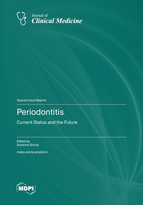Periodontitis: Current Status and the Future
A special issue of Journal of Clinical Medicine (ISSN 2077-0383). This special issue belongs to the section "Dentistry, Oral Surgery and Oral Medicine".
Deadline for manuscript submissions: closed (25 August 2022) | Viewed by 33760
Special Issue Editor
Special Issue Information
Dear Colleagues,
Periodontitis is a common inflammatory disease in which the composition of the oral biofilm as wells as the individual immune response have significant impacts. Severe periodontitis was amongst the most prevalent condition in the world in accordance to the Global Burden of Disease Study (2016), leading to periodontitis being a public health problem.
It is widely accepted that periodontitis may be a modifiable risk factor/modulator for several systemic diseases including diabetes, cardiovascular disease, adverse pregnancy outcomes, rheumatoid arthritis, chronic obstructive pulmonary disease, and chronic kidney disease. It seems to have an influence not only on the manifestation and progression but also on the prognosis of several systemic diseases. The biological plausibility linking periodontitis and various systemic diseases could, among other things, be due to bacteremia and the associated systemic inflammatory consequences. This raises the question of whether individualized periodontal therapy could possibly reduce the risk of the development of systemic diseases or positively influence their outcome.
Dr. Susanne Schulz
Guest Editor
Manuscript Submission Information
Manuscripts should be submitted online at www.mdpi.com by registering and logging in to this website. Once you are registered, click here to go to the submission form. Manuscripts can be submitted until the deadline. All submissions that pass pre-check are peer-reviewed. Accepted papers will be published continuously in the journal (as soon as accepted) and will be listed together on the special issue website. Research articles, review articles as well as short communications are invited. For planned papers, a title and short abstract (about 100 words) can be sent to the Editorial Office for announcement on this website.
Submitted manuscripts should not have been published previously, nor be under consideration for publication elsewhere (except conference proceedings papers). All manuscripts are thoroughly refereed through a single-blind peer-review process. A guide for authors and other relevant information for submission of manuscripts is available on the Instructions for Authors page. Journal of Clinical Medicine is an international peer-reviewed open access semimonthly journal published by MDPI.
Please visit the Instructions for Authors page before submitting a manuscript. The Article Processing Charge (APC) for publication in this open access journal is 2600 CHF (Swiss Francs). Submitted papers should be well formatted and use good English. Authors may use MDPI's English editing service prior to publication or during author revisions.
Keywords
- periodontitis and global health
- current pathophysiological understanding of periodontitis
- bidirectional interactions of periodontitis and systemic diseases
- impact of periodontitis on the prognosis of systemic diseases
- risk factors and modulators linking periodontitis and systemic diseases
- intervention studies: effect of periodontal therapy
- perspectives of an individualized periodontal therapy







